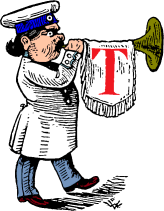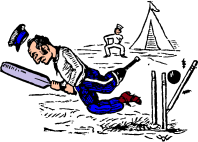HOME
Preface
Introduction
1
2
3
4
5
6
7
8
9
10
11
12
13
14
15
16
17
18
19
20
21
22
23
XVIII
CHAPTER XVIII.
BLAZONRY.
HE word Blazonry comes from the German word blasen, to blow, and originated in the custom of each knight blowing a trumpet on his arrival at a tournament. (The custom of blowing one's own trumpet is still maintained, but as tournaments have been abolished, and no corresponding games are extant, though football, according to the Rubly rules, is equally dangerous, it is now done at all times and seasons.) This blast was answered by the Heralds, who decribed aloud and proclaimed the arms and titles borne by the knights. Hence the term "Blazonry."
Heraldry is a science which, like old maids, is both arbitrary and exact, and therefore the rules of blazonry are always observed with the most rigid precision, no variations being permitted. In fact, any Herald attempting to stray from the beaten track would be liable to find himself castigated instead of the track on the ground of having been guilty of "false heraldry."
The first rule in Blazonry is to express the Heraldic distinctions in the proper terms, omitting nothing and avoiding tautology. This rule might, with great advantage, be applied to other than Heraldic descriptions. We have received letters which--but we will not particularise,--still, oh departed Aunt Jemima! if in another, and let us hope, a better world, spirits are allowed, as the mediums tell us they are, to revisit these glimpses of the moon, and you come across these lines, will not your conscience prick you?--but a truce to vain regrets, and we dash aside the manly tear, and proceed at once to
Secondly : In blazoning a coat, commence with the field, stating its colour or tincture. Then the lines must be mentioned by which it is divided, as per Pale, per Fess, or per Chevron, such lines belonging to the Honourable Ordinaries, and assuming the first place in the description, just as in a penny-a-liner's report of a public dinner the name of Sir Thomas Spriggles, Knight, precedes that of Common-Councillor Snooks.
Also, if such lines are indented, engrailed, or invected, the fact must not be omitted, otherwise it is taken for granted they are straight. Finally, their metal or colour must be given, or the description will come under the head of a shady one. Then follow the Sub-ordinaries or Common Charges.
Thirdly : As we have already observed, there must be no unnecessary repetition in blazoning; thus, where the field is white and the charges black, we should say "argent, a nose between two eyes sable," thereby intimating that both the nose and the eyes were black, a charge that would argue the proprietorship of somebody who had been in a fight, and one not unlikely to lead to an interview with a magistrate.
Fourthly: It would be wrong to say two eyes with a nose between them, because we must always begin with the charge that lies nearest the centre of the shield, and of course the nose, in one sense at least, must be the scenter. It may also have been on the principle of medio tutissimus ibis, which is an excellent rule when walking in a tunnel with two trains, each coming a different way.
Fifthly: Where a colour has been already mentioned, and it is necessary to avoid ambiguity to repeat it in describing a subsequent charge, we say, "of the first," "of the second," &c., as the case may be. Thus we should say, "Vert a head or charged with a bonnet of the first," which would denote that on a green field a head with golden or fashionable hair and a green bonnet on the head.
Sixthly : When no position is mentioned for an ordinary, it is understood to be in the middle of the shield--that being the most honourable place--just as the middle stump is the best to bowl over at cricket--if you can.
Seventhly: Where the charges are of the natural colour of the objects described, the word "proper" is used after them, thereby signifying that when otherwise they are improper, not that any of our readers need fear being shocked, seeing that Heraldry is one of the most decorous of sciences.
Eighthly: Where a sun-ray is borne otherwise than in the centre of the shield, the issuant point must be mentioned. Thus we should say:--"From a pie proper in chief four-and-twenty blackbirds issuant."
Ninthly: The number of points in a star or Mullet must be mentioned when more than five. If this rule were adhered to by dramatic critics it would be great gain, as we should then know whether a star was worth going to see, by the number of points he or she was able to make in his or her performance.
Tenthly: When three figures are upon the shield whose position is unmentioned, it is always understood that two are placed above and one below, thus carrying out the well-known betting cry of two to one on the field.
Eleventhly: When there are many figures of the same kind, their numbers and position in the field must be distinctly expressed, just as in the police courts the number and position in the force of the policemen giving evidence are always stated in the papers.
Finally, and Twelfthly: A metal must not be placed upon a metal, or a colour upon a colour, on pain of any quantity of penalties, too numerous to mention and too dreadful to contemplate. The only exception to this being that when a charge lies over upon a field partly of metal and partly of colour, and at this half-and-half arrangement the Heralds would wink. Marks of Cadency, chiefs cautons and bordures are also exempted from the general rule, some Heralds averring that they are not laid on the shield, but "cousu," or sewn upon it, a very sow-sow plan at the best.
XVIII
1
2
3
4
5
6
7
8
9
10
11
12
13
14
15
16
17
18
19
20
21
22
23
Preface
Introduction
HOME
Build: 2019/04/20 14:20:08.59+0900(JST)



